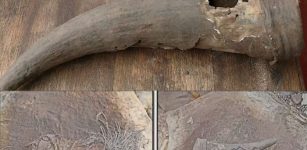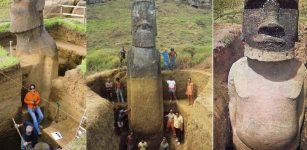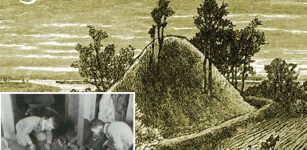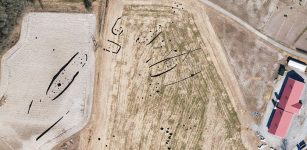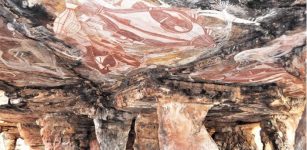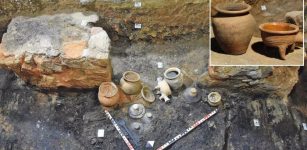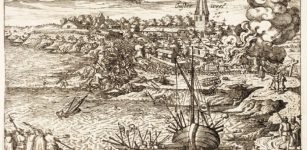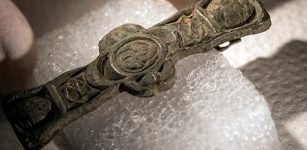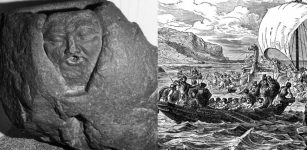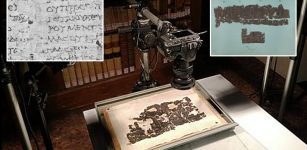History Of Middle Ages Altarpieces Has Been Re-Written
AncientPages.com - Every now and then scientists discover something that forces them to re-write history. This has just happened in the case of Middle Ages altarpieces.
It has long been assumed that altarpieces from the late Middle Ages were made in Germany, but this is not true.
A new study now reveals that several of them were in fact made in Norway. Altarpieces from the Middle Ages are a feature of many churches along the coast of Norway. They are often called Lübeck altarpieces, because it was assumed that the altarpieces were imported to Norway by the Hanseatics from Lübeck.
This altarpiece is from Kvæfjord church. Credit: Museum of Cultural History
Kristin Kausland, a postdoctoral fellow with the Department of Archaeology, Conservation and History at the University of Oslo, studied more than 60 altarpieces, most of them in Norway and Germany, but also several in Sweden and Denmark. Some of the altarpieces are in museums, others in churches along the Norwegian coast.
Since there is no written documentation on the origins of the altarpieces the physical clues are important, Kausland had to use other methods to find out the truth about Middle Ages altarpieces.
Using an infrared camera, UV camera and electron microscope, she searched for hidden clues and she was rewarded for her work.
"Through analyses of even the tiniest paint fragment I have sought to trace the physical prints of the craftsmen and the various production environments under which the objects were created. Call it, if you will, the craftsmen's fingerprints," Kausland said.
"In Germany, the craftsmen were organised in guilds. There were strict rules for what was allowed. For example, there were several places where the use of materials other than real gold was not permitted. At that time, churches were very dark. The idea was that these altarpieces should radiate toward you, creating the impression of something holy. They were supposed to shine, and give light," she explained.
The altarpieces that Kausland believes were made in Norway used imitation gold instead of real gold. In the Norwegian altarpieces, several types of oak were also used. This set them apart from the Northern German altarpieces, which were made of Baltic oak.
See also:
Murder Of Archbishop Thomas Becket: One Of Most Famous Crimes Of Middle Ages
The Bayeux Tapestry: One Of The Great Historical Records Of The Middle Ages
"In Norway, it appears that people used whatever was the most accessible. Nor were there any established forms of constructional design. It was a somewhat more pragmatic and practical approach, where the craftsmen were probably not governed by guild statutes. Among other things, you could mix different grades of oak," Kausland said.
Hidden Treasures And Unique Findings
Kausland believes that around ten of the 60 altarpiece she has studied were made in the Netherlands. This is a sensational discovery because almost all the altarpieces in the Netherlands were lost during the Reformation.
During the Reformation in the Netherlands the decision was made to destroy all of the decorations in the churches. The altarpieces were demolished. The fact that several such altarpieces are located in Norway is therefore of great international importance, she said.
The altarpieces are hidden treasures. At first glance they may be a little dark, but when you look past the layers of grime, and down to the original expression, you see that they are quite impressive. These are beautiful objects, which have been considered rather inferior art, and not part of Norwegian history. But they are an important part of Norwegian cultural heritage, and of fairly high quality, she notes.
This altarpiece from Austevoll Church is one of the pieces that Kausland believes was made in the Netherlands. What indicates that the piece was made in northern Netherlands are the techniques used in its construction, gilding, sculptures, as well as in the paintings. Credit: Svein Skare, Bergen Historiske museum, Universitetet i Bergen.
An altarpiece consists of several components. The inside of the case usually contains carved sculptures, while the inside of the doors can also have such sculptures or paintings. An altarpiece is therefore the creation of several craftsmen.
In the past, it was believed that these Norwegian craft traditions died out during the Black Death. Kristin Kausland's research shows that the traditions continued to live on.
It is also likely that there was a great deal of collaboration across national borders, by which the construction of the case was done in Bergen, while the finer wood carving art was done down on the continent, she explained.
AncientPages.com
Expand for references



